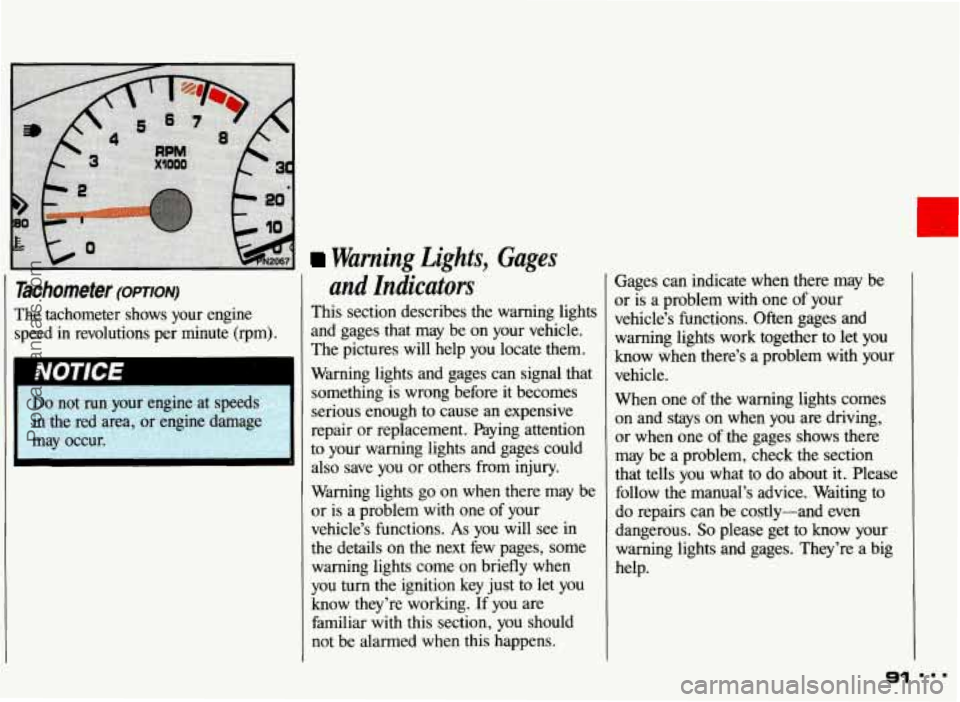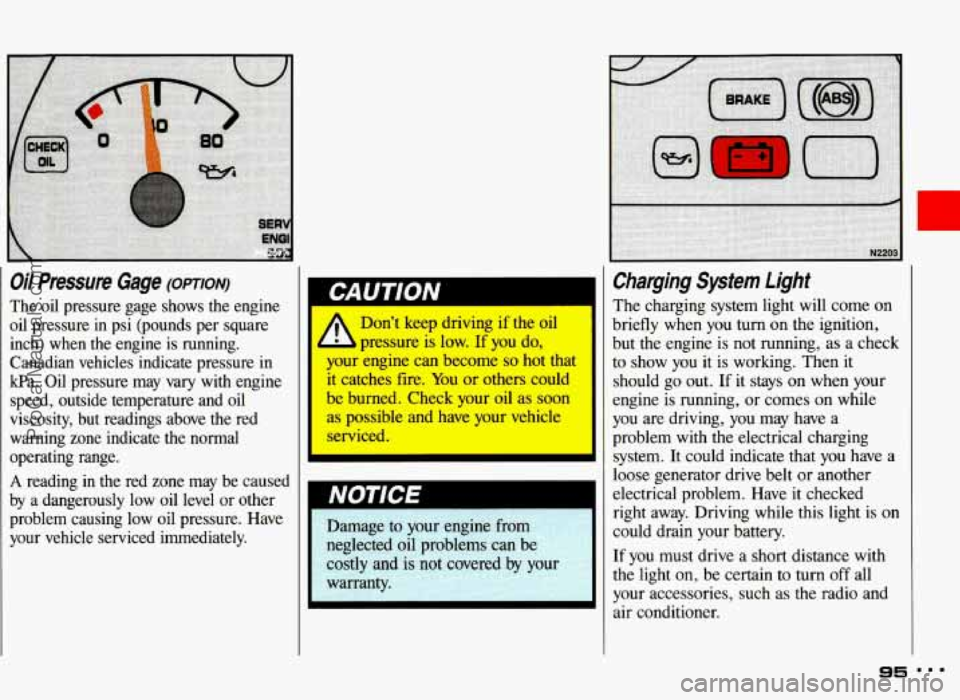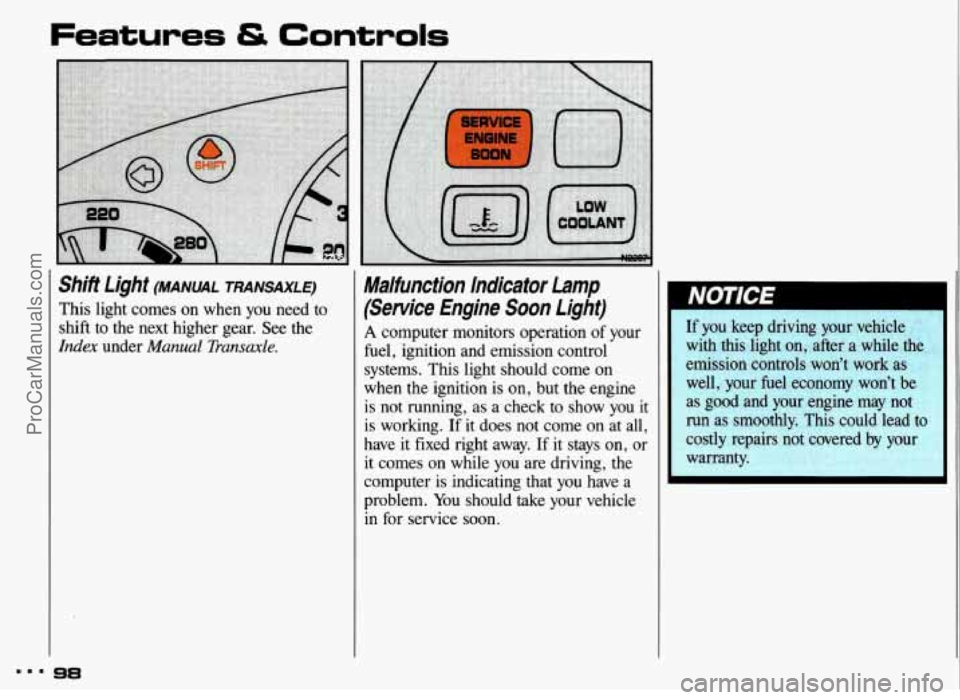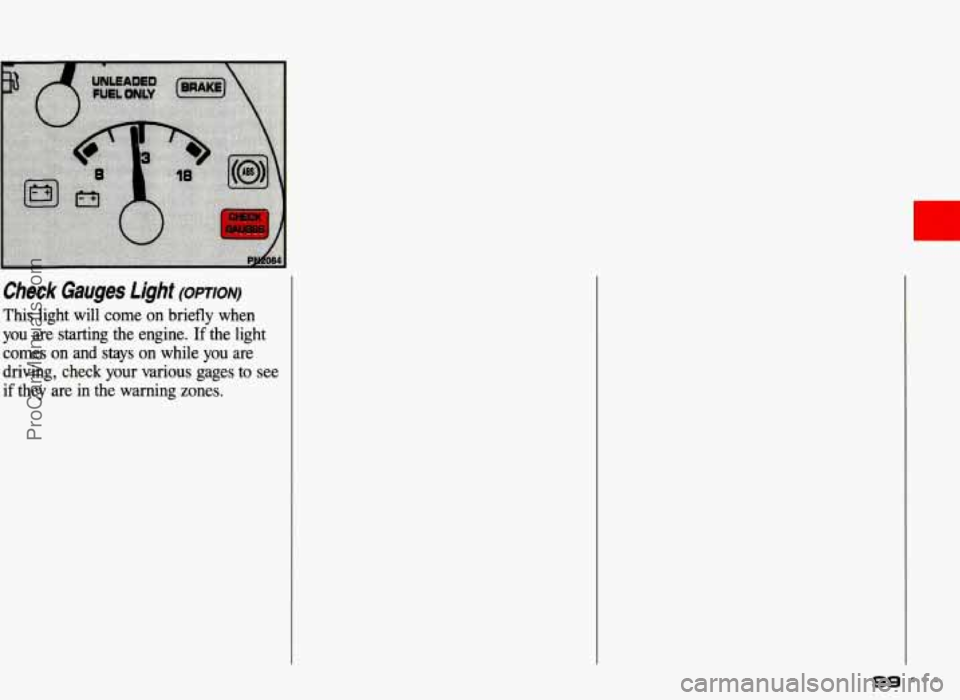1993 PONTIAC GRAND-AM check engine
[x] Cancel search: check enginePage 55 of 306

Features & Controls
Both Transax/es (CONTI
Holding your key in Start for
longer than
15 seconds at a time
will cause your battery
to be
drained much sooner. And the
excessive heat can damage your
starter motor.
4. If your engine still won’t start (or
starts but then stops), it could be
flooded with too much gasoline.
Try
pushing your accelerator pedal all tht
way to the floor and holding it there
as you hold the key in
Start for abou
three seconds. This clears
the extra
gasoline from the engine. If the
vehicle
starts briefly but then stops
again, do the same thing, but this
time keep the pedal about one-
quarter of the way down for five or
six seconds. Your
engine is designed to work
with the electronics in
your
vehicle. If you add electrical parts
or accessories, you could change
the way the
fuel injection system
operates. Before adding electrical
equipment, check with your dealer.
If
you don’t, your engine might not
perform properly.
If you ever have to have your
vehicle towed, see the part of this
manual that tells how to
do it
without damaging your vehicle. See the
Index under Towing Your
Pontiac.
To Start Your 3300 V6 Engine
(Code N):
1. Don’t push the accelerator pedal
before starting your engine. In some
other vehicles you might need to
do
this, but because of your vehicle’s
computer systems, you don’t.
2. Turn your ignition key to Start.
When the engine starts, let go of the
key. The idle speed will go down as
your engine gets warm.
3. If it doesn’t start right away, push the accelerator pedal about one-quarter of the way down while you
turn the
key to
Start. Do this until the engine
starts.
As soon as it does, let go of
the key and the accelerator pedal.
m.. 54
ProCarManuals.com
Page 56 of 306

NOTICE
Holding your key in Start for
longer than
15 seconds at a time
will cause your battery to be
drained much sooner. And the excessive heat can damage your starter motor.
4. If your engine still won’t start (or
starts but then stops), it could be
flooded
with too much gasoline. Try
pushing your accelerator pedal all thl
way to the floor and holding
it there
as you hold the key
in Start for abou
15 seconds. This clears the extra
gasoline from the engine.
Turn the
ignition key to
Off. Wait 10 seconds:
then repeat step
3.
1lL
Your engine is designed to work
with the electronics in your
vehicle.
If you add electrical parts
or accessories, you could change
the way the fuel injection system
operates. Before adding electrical
equipment, check with your dealer.
If you don’t, your engine might not
perform properly.
If you ever have to have your
vehicle towed, see the part of this
manual that tells how to do it
without damaging your vehicle.
See the
Index under Towing bur
Pontiac.
Triving Through Deep Standing
Vater
NOTICE I
If you drive too quickly through
deep puddles or standing water,
water can come in through your
engine’s air intake and badly
damage your engine. If you can’t
avoid deep puddles or standing
water, drive through them very
slowly.
5E ...
ProCarManuals.com
Page 92 of 306

Warning Lights,
Gages
Tachometer (omtoN)
The tachometer shows your engine
speed in revolutions per minute (rpm).
and Indicators
This section describes the warning lights
and gages that may be on your vehicle.
The pictures will help you locate them.
Warning lights and gages can signal that something is wrong before it becomes
serious enough to cause
an expensive
repair or replacement. Paying attention
to your warning
lights and gages could
also save you or others from injury.
Warning lights go on when there may be
or is a problem with one of your
vehicle’s functions.
As you will see in
the details on the next few pages, some
warning lights come on briefly when
you turn the ignition key just to let you
know they’re working. If you are
familiar with this section, you should
not be alarmed when this happens. Gages can indicate
when there
may be
or is a problem with one of your
vehicle’s functions. Often gages and warning lights work together to let you
know when there’s
a problem with your
vehicle.
When one of the warning lights comes
on and stays
on when you are driving,
or when one of the gages shows there
may
be a problem, check the section
that tells you what to do about it. Please
follow the manual’s advice. Waiting to
do repairs can be costly-and even
dangerous.
So please get to know your
warning lights and gages. They’re a big
help.
91
ProCarManuals.com
Page 95 of 306

Oil Warning Light (CONT.)
The oil light could also come on in three
other situations:
When the ignition is on but the engine
is not running, the light will come on
as a test to show you it is working, but
the light will
go out when you turn the
ignition to
Start. If it doesn’t come on
with the ignition on, you may have a
problem with the fuse or bulb. Have
it
fixed right away.
Sometimes when the engine is idling
at a stop, the light may blink on and
off. This is normal.
If you make a hard stop, the light may
come on for a moment. This is
normal.
I
Don’t keep driving if the oil
your engine can become so hot that
it catches fire. You or others could
’ ; burned. Check your oil as soon
ab possible and have your vehicle
serviced.
E pressure is low. If you do,
‘CHECK I
OIL
,4-;, Damage to your engine from
;; neglected oil problems can be
,’: costly and is not covered -1 by your
i:.. warranty. , 1.
I
1
Check Oil Light
This light should come on briefly when
you
turn your ignition key to Run. It
also comes on and stays on when the oil
level in your vehicle is low. If this
happens, park your vehicle
in a level
place, check your
oil level and bring the
engine
oil up to its proper level. See the
Index under Engine Oil.
ProCarManuals.com
Page 96 of 306

Oil Pressure Gage (omrorv)
The oil pressure gage shows the engine
oil pressure in psi (pounds per square
inch) when the engine is running.
Canadian vehicles indicate pressure in
kPa. Oil pressure may vary with engine
speed, outside temperature and
oil
viscosity, but readings above the red warning zone indicate the normal
operating range.
A reading in the red zone may be caused
by a dangerously low oil level
or other
problem causing low oil pressure. Have
your vehicle serviced immediately.
A
Don’t keep driving if the oil
pressure is low.
If you do,
your engine can become
so hot that
it catches fire. You or others could
be burned. Check your oil as soon
as possible and have your vehicle
serviced.
Charging System Light
The charging system light will come on
briefly when you
turn on the ignition,
but the engine is not running, as a check
to show you it is working. Then it
should go out.
If it stays on when your
engine is running, or comes on while
you are driving, you may have a
problem with the electrical charging
system. It could indicate that
you have a
loose generator drive belt or another
electrical problem. Have it checked
right away. Driving while this light is on
could drain your battery.
If you must drive a short distance with
the light on, be certain to
turn off all
your accessories, such as the radio and
air conditioner.
95
ProCarManuals.com
Page 99 of 306

Features tS Controls
!
-
Shift Light (MANUAL TRANSAXLE)
This light comes on when you need to
shift to the next higher gear. See the
Index under Manual Transaxle.
98
Malfunction Indicator Lamp
(Service Engine Soon Light)
A computer monitors operation of your
fuel, ignition and emission control
systems. This light should come on
when the ignition is on, but the engine
is not running, as a check to show you
it
is working. If it does not come on at all,
have it fixed right away.
If it stays on, or
it comes on while you are driving, the
computer is indicating that
you have a
problem. You should take your vehicle
in for service soon.
If you keep driving your vehicle
with this light on, after a while the
emission controls won’t work as
well, your fuel economy won’t be
as good and your engine may not
run as smoothly. This could lead to
costly repairs not covered by your
warranty.
ProCarManuals.com
Page 100 of 306

. .. . ..
Check Gauges Light (opTIoN)
This light will come on briefly when
you are starting the engine. If the light
comes
on and stays on while you are
driving, check your various gages to see
if they are in the warning zones.
c
99 === ProCarManuals.com
Page 108 of 306

Audio Systems
The following pages describe the audio systems available for your Pontiac, and how
to get the best performance from them. Please read about the system in your
vehicle.
Hearing damage from loud noise is almost undetectable until it is too
- late. Your hearing can adapt to higher volumes of sound. Sound that
I st IS normal can be loud and harmful to your hearing. Take precautio\
ns by
1
adjusting the volume control on your radio to a safe sound le\
vel before your
hearing adapts
to it.
1 To help avoid hearing loss or damage:
I
1. Adjust the volume control to the lowest setting.
2. Increase volume slowly until you hear comfortably and clearly.
Before you add any sound equipment to your vehicle-like a tape player,
CB
radio, mobile telephone or two-way radio-be sure you can add what you
want.
If you can, it's very important to do it properly. Added sound equipment
may interfere with the operation of your vehicle's engine, Delco@ radio or
other systems, and even damage them. And, your vehicle's systems may
interfere with
the operation of sound equipment that has been added
improperly.
So, before adding sound equipment, check with your dealer and be sure to
check federal rules covering mobile radio and telephone units.
Setting the Clock
No matter which audio system you have
in your vehicle, setting the clock is easy.
1 , With the ignition on and radio on or
off, press SET. The SET indicator
will appear on the digital screen for
five seconds.
2. You must begin to set the clock to the
correct hour and minute during those
five seconds.
Depress
VSEEK or 4SEEK to set
the hour.
Depress
SEEU or SEEK, to set
the minute.
107 " '
ProCarManuals.com